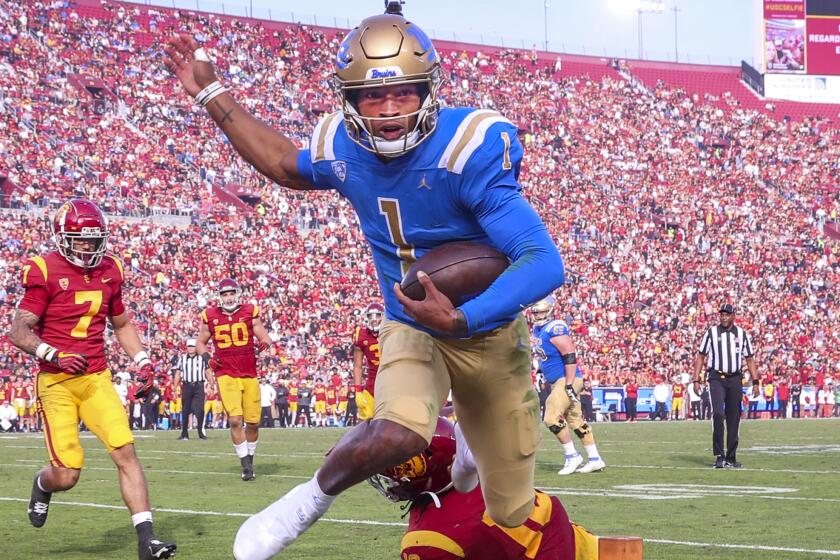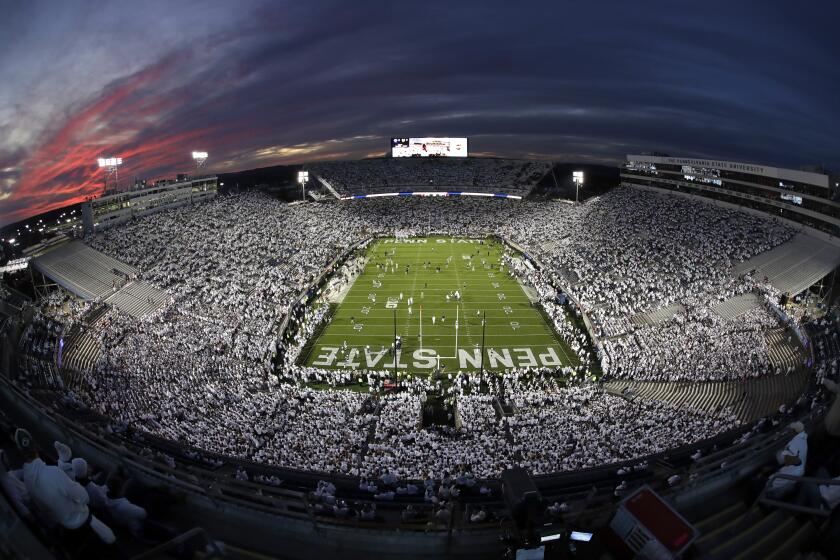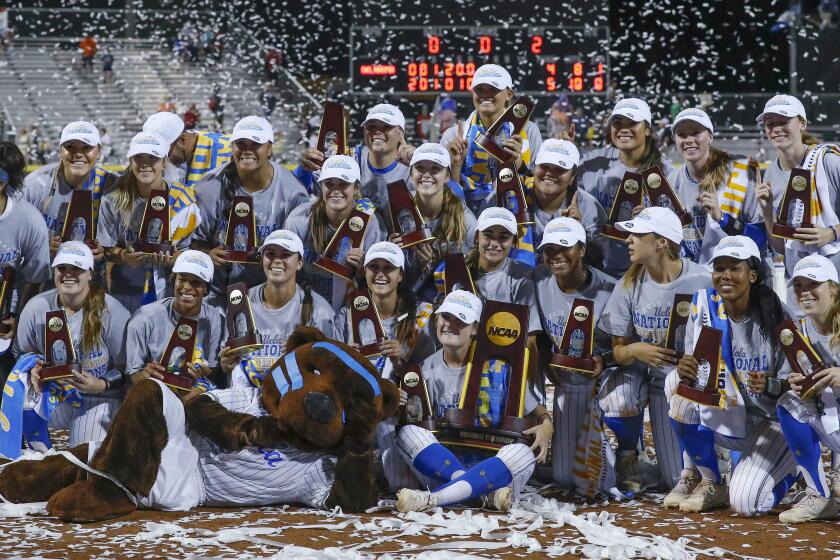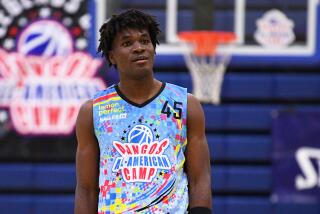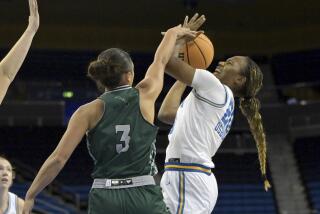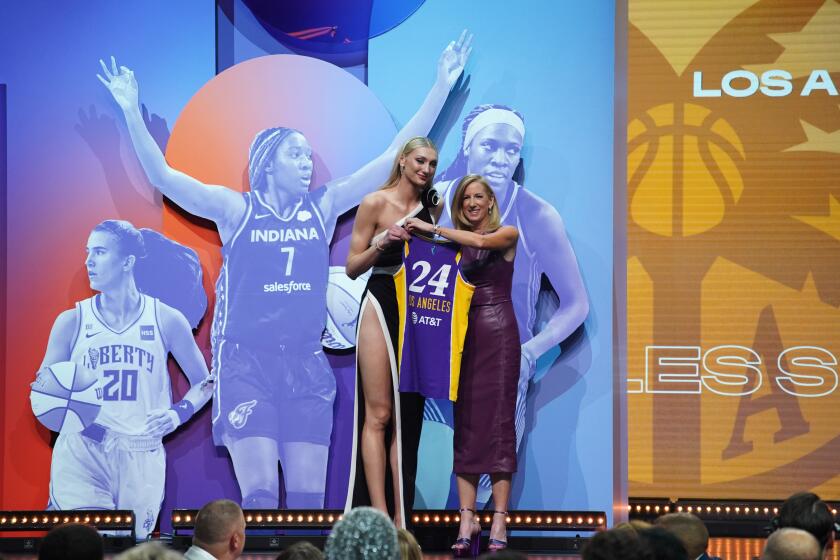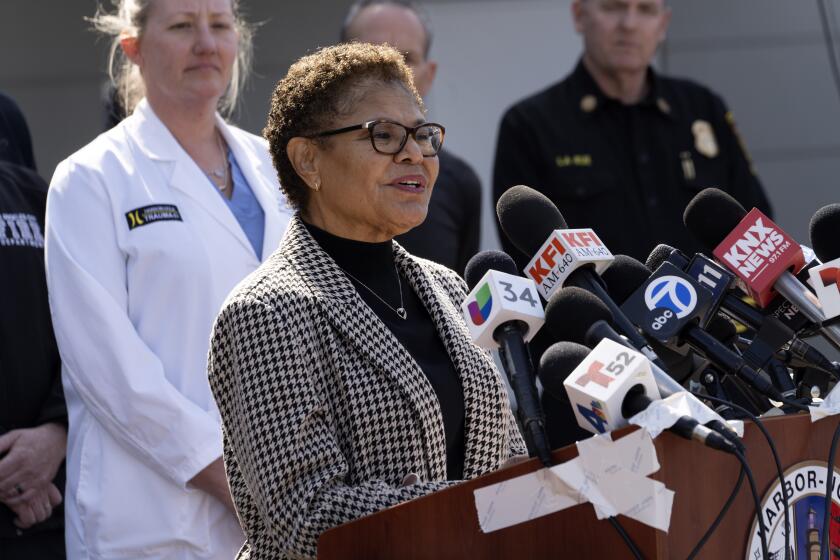Naps, yoga and chargers. What UCLA and USC can learn from Hawaii’s travel experiences
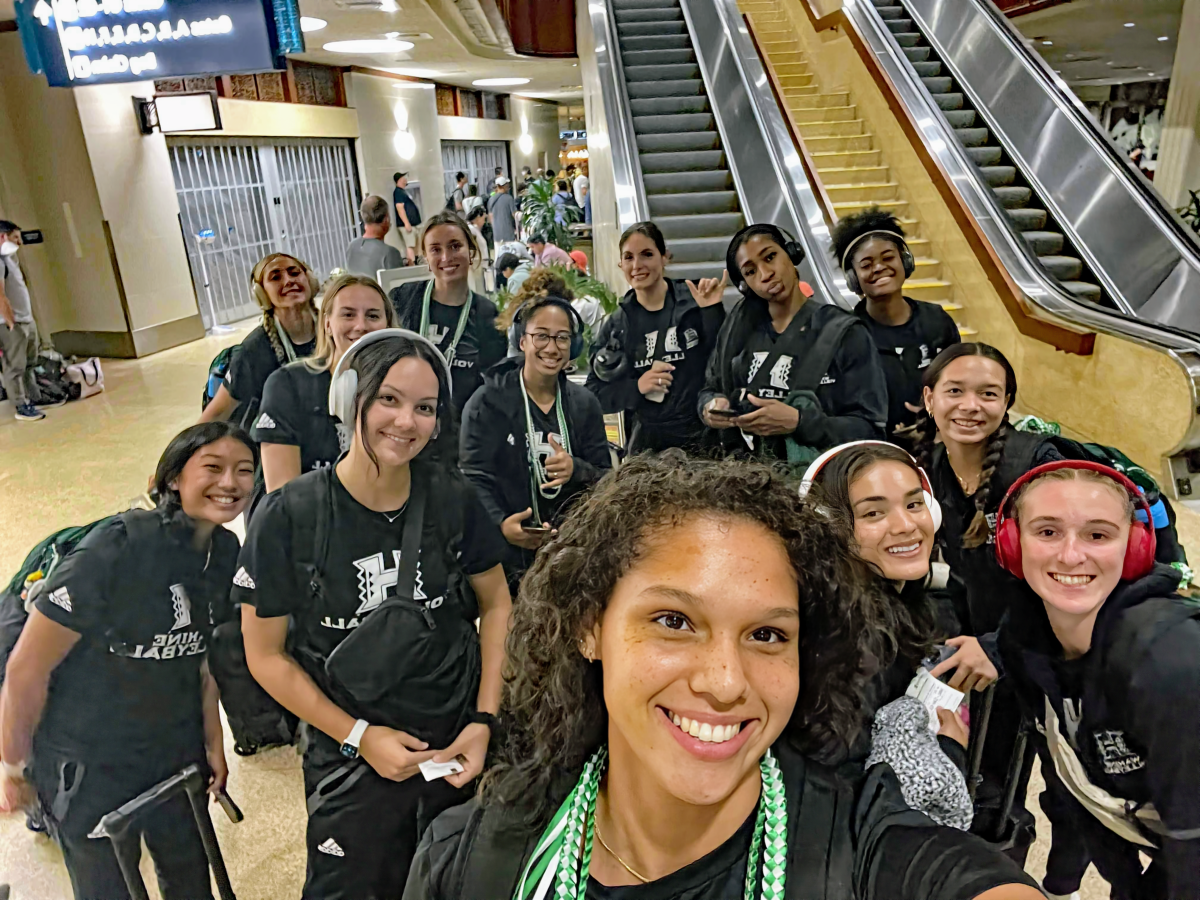
They download their favorite Netflix shows, organize their homework assignments and charge their electronics. Whether on the field or in the skies, preparation is everything for Hawaii.
For college sports teams, a road trip that balances academic and athletic pressures is a precise science. The Rainbow Warriors have Ph.D.s in the discipline. Flying six hours one way to play their closest conference foes every other week, Hawaii athletic programs provide a timely case study for UCLA and USC, which will be due for an upgrade to their frequent-flyer status once they join the Big Ten Conference in 2024.
Similar to their island peers, the Trojans and Bruins will be in for approximately five-hour flights when they play at Maryland or Rutgers, the two farthest Big Ten outposts. Visiting eight of the 14 current Big Ten members will require the same three-hour time change for the West Coast schools that Hawaii teams experience when they come to California.
USC and UCLA are leaving the Pac-12 for the Big Ten Conference in 2024, the two schools announced Thursday.
The secrets for conquering the skies are vast and unique. Volleyball player Mylana Byrd sleeps on the plane by bringing a small pillow for her neck and covering her eyes in case of spontaneous cabin lighting with a blanket. Kamaka Hepa, a forward on the men’s basketball team, loads up on anime series, tries to get at least three hours of sleep on each flight and is always prepared to barter with coaches to get a seat with more leg room to accommodate his 6-foot-10 frame.
When it comes to UCLA‘s and USC’s upcoming moves, Dominic Drury, the Hawaii men’s basketball director of operations, kept it simple.
“The best advice,” Drury said, “is just to put the athletes in the best position to succeed.”
Drury is the primary cog of the Hawaii men’s basketball program’s travel. He books the flights, reserves hotels and schedules each day’s activities, reserving time for everything from meals, study hall, practice, film and recovery. The moment the Big West releases the conference schedule, he springs into action.
Booking as early as possible alleviates many travel headaches, especially because Hawaii, which has a partnership with Hawaiian Airlines, travels commercially for most trips. A travel agent assigns seats and advanced planning helps ensure players who are close to seven-feet tall can at least get some extra comfort in aisle seats.
USC and UCLA, backed by an expected increase in revenue from the Big Ten move, likely will avoid the hassle of commercial flights in favor of more comfortable charter planes. But no amount of additional leg room will shorten the distances between the L.A. schools and their future conference foes.
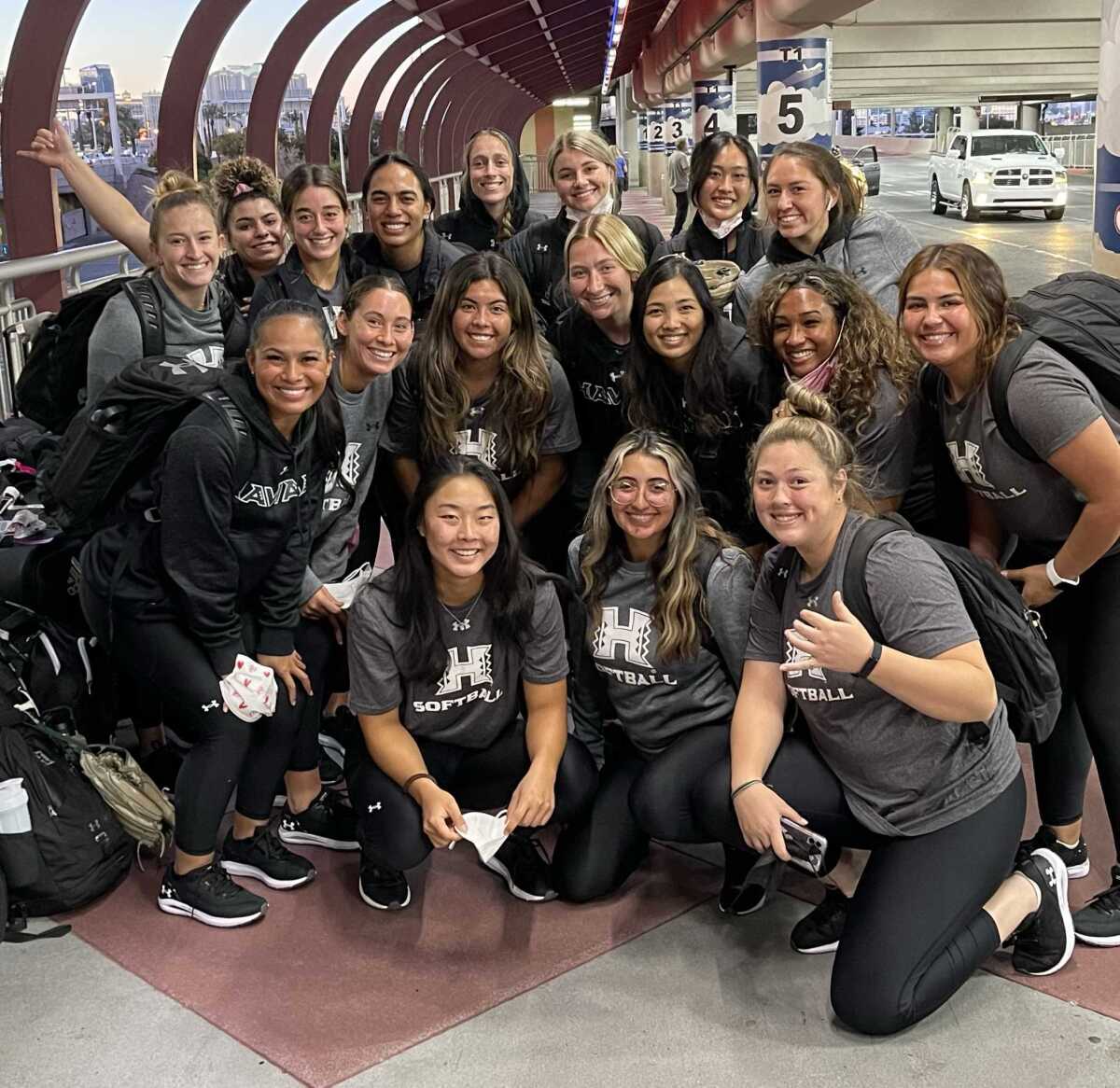
Even the closest Big Ten school — Nebraska — is around a three-hour flight from Los Angeles. A bigger problem might be crossing multiple time zones. Six Big Ten schools are on Central time, while eight are on Eastern time.
To compensate for the three-hour difference between Hawaii and California, Hawaii leaves two days before their competition instead of the typical mainland schedule of traveling one day before. Once the softball team landed in California for a conference series and got to its hotel, shortstop Nawai Kaupe immediately started preparing her body for games by doing yoga and meditation, specifically lying on her back and extending her legs up a wall to help blood flow. The 2022 Big West defensive player of the year encouraged her teammates not to look at their phones to help them get to sleep on time and get on the adjusted schedule as soon as possible.
The extra day is critical to get athletes acclimated but comes with a difficult downside.
“We miss more class probably than any other team in the country,” Drury said.
More important than Byrd’s plane ritual is her first-day-of-classes routine. The senior setter majoring in biological engineering presents her professors with the athletic department’s travel letters explaining her role on the volleyball team and that she will be missing class for select road trips. She meets her professors, looks them in the eye and ensures they know who she is.
Byrd, a transfer from Alabama, always made it a point to greet her professors early in the semester at her previous school, but the practice is even more important at Hawaii because of the increased in-person absences.
“It’s definitely creating life skills for us,” Byrd said. “You have to have time management, you have to have good communication with your professors.”
USC and UCLA athletes better get used to the idea of spending a lot of time outside California once the schools make the jump to the Big Ten.
Athletes must be independent learners, academic advisor Kari Ambrozich said. The former Hawaii volleyball player and assistant coach who now works with the football, men’s basketball, women’s volleyball and beach volleyball teams said the best part of her job is working with academically driven athletes like Byrd, who take on challenging STEM (science, technology, engineering, and math) majors. But it presents an especially difficult puzzle to solve.
Many STEM majors require labs. Ambrozich tries to secure the once-weekly, four-hour in-person sessions for an athlete’s offseason. When majors require labs in both semesters, getting one for Monday or Tuesday before the team leaves for a road trip is the perfect fit.
But even threading the weekly class needle sometimes isn’t enough when teams are on the road for extended periods. Former Hawaii linebacker Darius Muasau, who transferred to UCLA this year, remembered when the Mountain West scheduled back-to-back road games for Hawaii at Fresno State and Wyoming to start the 2020 season. The Warriors stayed on the mainland for two weeks and did all their homework online.
The routine is familiar for the men’s basketball team that stays on the mainland for two weeks at the end of the regular season into the conference tournament in Las Vegas. If the Warriors make the NCAA tournament, the mainland stay stretches to three weeks, often overlapping with midterms.
Softball and gymnastics should thrive, but other USC and UCLA Olympic sports will face more formidable challenges after moving to the Big Ten.
Ambrozich accompanies her teams for longer trips to proctor exams and monitor study hall sessions. Drury schedules at least an hour-long study hall every day on the road, even game days, because making the most of every available minute is critical for athletes trying to stay ahead of their studies.
“They’ve got to learn to advocate [for themselves],” Ambrozich said of her advice to UCLA and USC athletes when they take on a Big Ten schedule. “I feel like some students are a little nervous to do that with their coaches, but communication is key, and I think if coaches know that, they can think about that when they’re putting their schedule together.”
Living in paradise comes at a price for Jun Hernandez, although the Hawaii women’s tennis coach has learned how to make the most of his budget.
When flying his team to the mainland for its Big West matches — a trip he says costs between $15,000 and $20,000 each time — Hernandez adds one or two nonconference matches to maximize the travel and guard against possible rainouts. Combined with preseason tournaments that attract top teams to Hawaii because of an NCAA exemption that allows visiting teams not to count a match at Hawaii against their NCAA-max 25 competition dates, Hernandez is still able to piece together a competitive schedule that helped the Rainbow Wahine make their only two NCAA tournament appearances and gives their individual players enough top-ranked matches to qualify for the NCAA singles tournament.
Could USC and UCLA repeat the same strategy when they join the Big Ten?
“They have to be creative,” Hernandez said.

Hernandez, who was an assistant at California before taking over at Hawaii in 2006, relies on his existing relationships with other coaches to schedule competitive matches and make sure his team is taken care of on the road. To ensure proper recovery time, Hernandez shies away from scheduling matches on consecutive days and requests afternoon matches to accommodate the three-hour time difference. He even asks opposing schools for access to their cold tubs and training rooms to help his players recover after long plane rides.
Hernandez has found other coaches to be fair competitors who are open to collaboration.
“It’s all about relationships,” Hernandez said. “You wouldn’t want to play a school that you have some issues with,” he added, laughing.
UCLA and USC’s history in the Pac-12 could be especially beneficial for teams that will rely on nonconference matches to strengthen their schedule after moving to the Big Ten. Softball, women’s basketball and tennis all thrive in the Pac-12 and maintaining rivalries with West Coast counterparts could help overcome the strength of schedule dip looming in the Big Ten.
UCLA and USC both acknowledged the increased travel requirements when the move was announced this summer. UCLA athletic director Martin Jarmond said in his first statement that the schools would “explore scheduling accommodations” with the Big Ten.
Unique solutions for some sports may resemble the way Hernandez hosts round-robin tournaments during the nonconference season. The Big Ten could have several teams from Olympic sports gather in one city for several days as opposed to chauffeuring them back and forth across the country in short order.
The meet-in-the-middle solution isn’t always available for Hawaii, which makes the difficult travel almost like their own competition, except they battle the skies with neck pillows, eye masks and fully charged iPads.
“Here in Hawaii, we know the trials and tribulations we go through with being the team that travels the most,” Byrd said. “But we do it for a reason: We do it to play, we do it to win and we do it to show these teams that we’re not messing around. We travel for business.”
More to Read
Get our high school sports newsletter
Prep Rally is devoted to the SoCal high school sports experience, bringing you scores, stories and a behind-the-scenes look at what makes prep sports so popular.
You may occasionally receive promotional content from the Los Angeles Times.

